The escape from Lima starts in the psychotic inner streets where buses and taxi drivers in queues of motionless cars sound their pitiless horns of anger and lament as ambulantes thread between the vehicles offering cold drinks, sunglasses and children’s toys. At the traffic lights, a Venezuelan juggles knives whilst balancing on a board on a basketball, and at the next a man in a spiderman costume performs handstands and flips, and as the light turns green the drivers and their horns scream and wail and race ahead, cutting across lanes and surging forward to the next impasse. They may have little for themselves, but they can at least destroy the opportunities of others. Five hundred years of national self-harm is played out as live theatre on the highways every day.
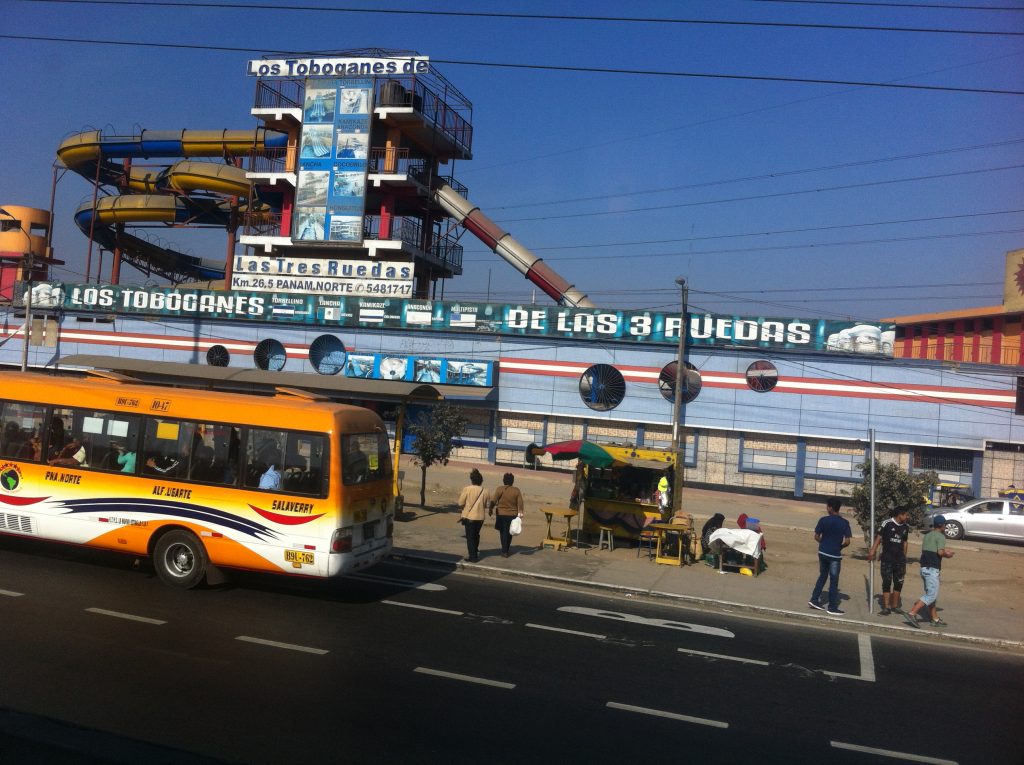
The fast moving PanAmerican offers a three lane racetrack leaving the urban sprawl of Lima to head along the coast, with a grey sea on the right, behind low concrete block houses and dusty lanes. Thirty minutes later we reach an area of green lawns, an irrigated desert of death, an exclusive and expensive cemetery run by Lima’s Catholic Taliban, the Sodalicio, whose sexual abstinents live in private gated communities with maids, cleaners, gardeners and wide screen TVs. The burial ground lies below the hilltop shrines of Pachacamac, where the Wari and Ychsma people buried their dead for a thousand years before the Spanish came.
I am beginning to relax as we reach the edge of the city. Amy is sitting in the front besides the driver, eagerly looking out of the window. This is her first trip out of Lima. Mayra and I are on the back seat. Mayra is revisiting parts of Peru she has not seen since she was a child, while for me, I feel it is something of a farewell tour. My empathy with the country is weakening.
We pass through desert and delta again, the fertile coastal lands of successive seasonal rivers. Each has its pyramid mounds standing above the irrigated plains. Most have never been excavated, but I have visited many, and Mayra has read about them, so we have a lot to share. After Pachacamac by the river Lurin, there is Cerro Paloma in Chilca, then Huaca El Salitre, at the mouth of the Rio Mala, Huaca Malena, Cerro Azul on the headland and Cerro d’Oro rising inland, the twenty low mounds of Vilcahuasi, Ungara by the Rio Cañete and then beyond to Chincha with La Cumbe, Cerro de Gentil and El Mono, Huaca Soto and La Centinella.
Entering the broad plains of Cañete we see the gently folded brown hillside of Cerro d’Oro on the left. We miss the exit from the Panamerican Highway but our driver Juan slings the Dodge down and over the central ditch of the dual carriageway, then plunges off the road along a canal-side track between fields. We pass cotton, peppers and sweet potato, cross the old highway south, which is now a simple back road, and drive through the historic slave estate, the hacienda of San Luis, to the nineteenth Japanese cemetery on the flanks of the Hill of Gold, the Cerro d’Oro.
We climb the barren hillside to the killing fields of corpses disinterred and scattered. Amy is aghast, but curious. A buho, a burrowing owl, watches us warily from the entrance to its underground nest. From here if we raise our eyes we can look out over the green valley with its network of irrigation canals, and beyond to the sea. And if we look down we are surrounded by thousands of exhumation pits, grave-robbers’ diggings, with discarded fragments of cloth, broken ceramics, skulls and bones. Mayra has not been here, and the fragments of coloured ceramics painted with a delicate purple are enough to make the hill climb worthwhile.
****************
An hour later, we reach the long wide bay of Paracas. In an elegant concrete museum on the desert sands we learn of the discovery by Julio Tello, a native of Huarochiri, of hundreds of mummy bundles buried in shaft graves on the side of the nearby Cerro Colorado. The richly embroidered cloths wrapping the mummies are the artistic peak of Peru’s rich textile tradition, though they were created more than two thousand years ago. From the upper balcony, we look out across the bay, where hundreds of flamingos are standing in the distant shallows.
The beaches of the Paracas reserve are covered in sea shells and bleached bones. I show Mayra the long, light hollow bone of a large sea bird, a flamingo or a pelican, the length of my lower arm. It would be perfect for making a flute, as they did at Caral. Then we find the same bone, anatomically, but thick and heavy, shorter than my hand: the leg, or flipper, of a sea lion. Amy gathers shells and skims stones over the water.
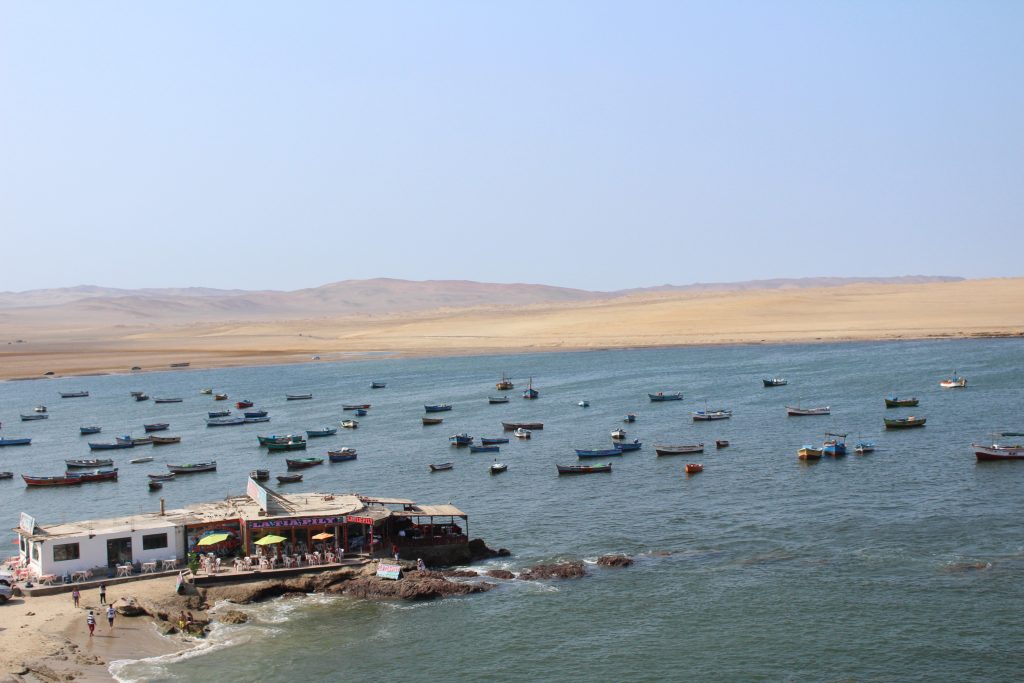
Cruise ships moor here and people are taken ashore to clamber into minibuses and visit the Nazca lines or the pisco distilleries of Ica. One tourist venue is the oasis of Huacachina, a natural lake of fresh water surrounded by sand dunes. In recent years the municipality has had to periodically refill the lake from tankers. The water table is dropping as commercial farms, and private beach resorts, suck up the groundwater with illegal wells and pumps.
After overnighting in Pisco we head inland to Tambo Colorado, another tour destination. The straight lines of the Inca are evident here, with a wide rectangular yard or kalanka, as big as a football pitch, and trapezoidal niches in the walls on either side, painted red and orange. There is a complex of small internal storage rooms and pits, linked by narrow passageways. These are measured, square, accountant’s buildings, a prominent visible presence above an Inca road from Cusco to the coast.
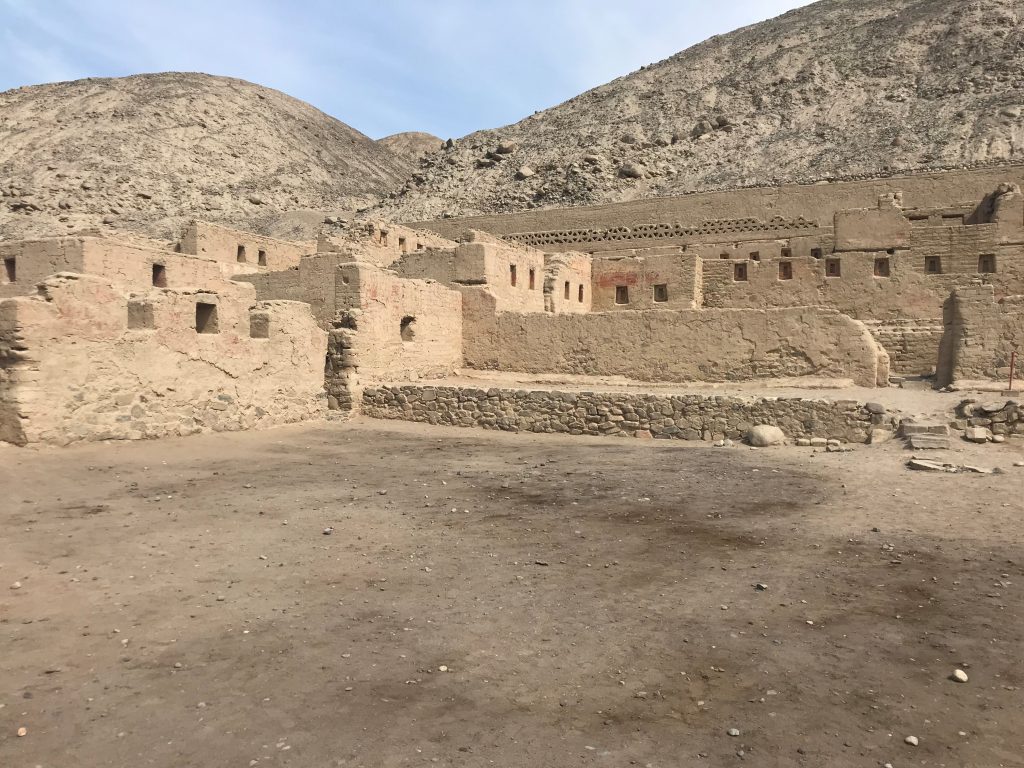
The surroundings are brown and bare and the air hot and dry, as the road, El Camino de Los Libertadores, climbs steeply upwards through the Pisco valley. But the air grows cooler and the hillsides start to display rootless succulents and then cactus. At three thousand metres, bushes with blue and yellow flowers grow out of the stony steep hillsides of the switchback road. There are clouds above and the air is cold.
When the radiator overheats we have a view across the valley to a series of andenes, pre-Hispanic terraces on the hillside, with farmers grazing cows in fields far below. Amy silently fetches her pastels and starts sketching.
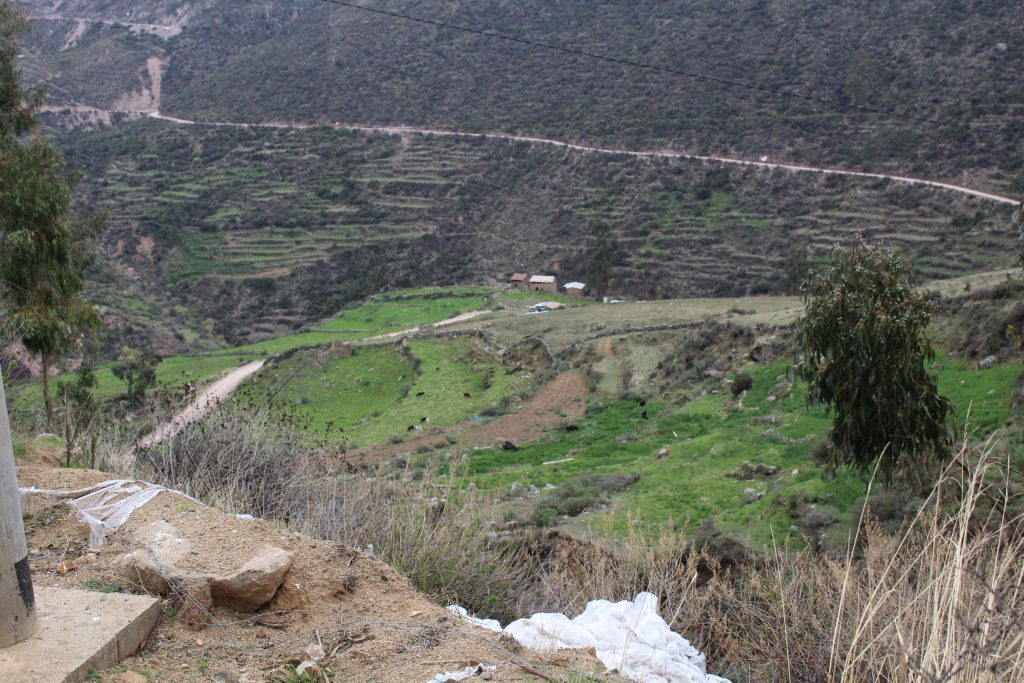
We are at 4194 metres and still climbing. Juan fills a container from the stream that runs under the road at Puente Rantamayo. Brown and yellow woodpeckers, Andean flickers, swoop down from the branches of a tall eucalyptus. Dark grey clouds are dropping heavy rain on the nearby hills.
That day we cross the Andes at 4746 metres, at the Abra Apacheta, the pass of cairns, chewing cocoa leaves. As we descend towards Ayacucho, we see many deserted buildings, from the years when the people fled terror, from the 1980s. But there are also well farmed fields, alpaca in the higher lands and cattle in the valleys.

Eating pizza that evening in the stone paved courtyard of an elegant old colonial house in Ayacucho, we watch twenty students practice their dances from another place and time. Boys and girls form swirling twisting lines, dipping and turning, moving across the square.
I ask the girl managing the CD player why they are dancing.
“We are preparing for the carnival next month,” she replies, breathless with excitement.
“Is it a dance from the selva?”
“No it is our dance, from here, from Ayacucho.”
But to me, it brings to mind the sacred dance of the Yanesha. “After one turn around the dance area the undulating row of dancers reproduces the X-patterned movement of the Milky Way in a twenty-four hour period.”
There are Yanesha dancers here too, on the streets of Ayacucho, dressed in their long brown cushmas, performing with drums and whistles, twirling flirtatiously round tourists. We have travelled 230 kilometres from the coast, and are at a little less than 3000 metres; if we continue just 80 kilometres further west we will be in the Amazon.
************************************************
Climbing out of the valley the next morning we confront more rain and low cloud, starting at 3300 metres. For nearly two hours we cross the high pampas over 4000 metres, seeing occasional livestock and isolated dry stone buildings.
Later, lightning begins to strike the nearby hills. As we start to descend, a sudden hail storm covers the winding roads with rounded grains of ice the size of peas. Juan slowly follows tire tracks down the centre of the road, waiting for the ice to melt.
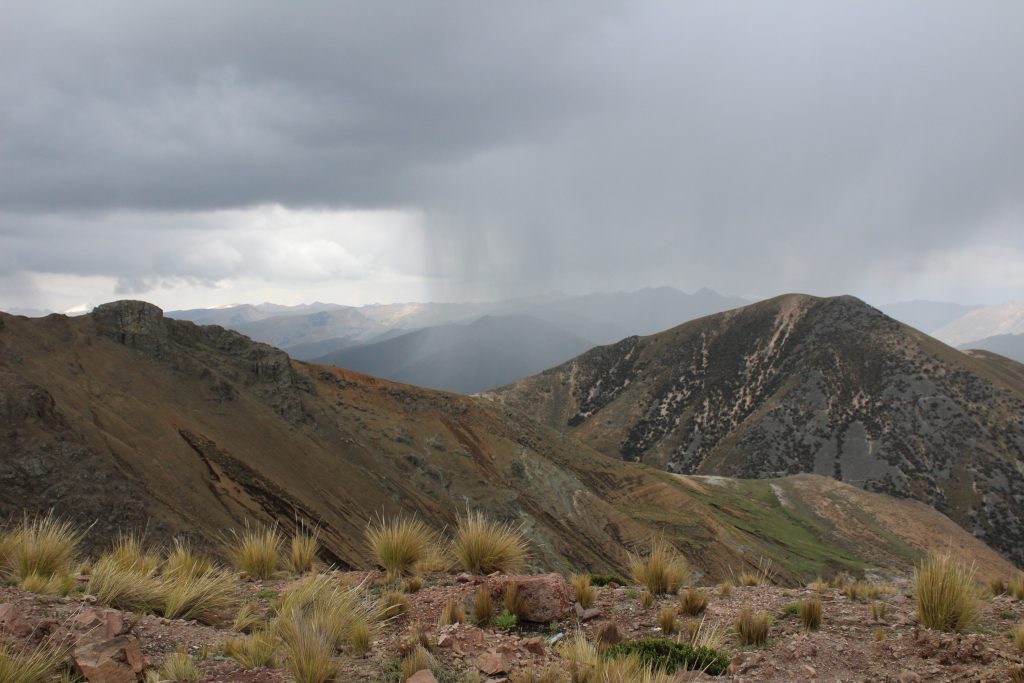
We see a boulder detached from the earth embankment lying halfway across the road in a bed of red soil. We continue, skirting rockfalls in the roadway. There are very few cars travelling in the opposite direction, perhaps three in an hour. But more pass us, overtaking on the narrow roads, one almost colliding with a truck which comes rapidly round a blind bend to face a rock fall in the centre of the route.
Twice the mud falls have spread across the road and we see them suddenly, through the fog, as we round a sharp bend. Our tires are not the first to leave their marks in the red brown earth. They are perhaps the second or the third.
“We are lucky it is only earth,” said Juan laconically, “if it were rocks we would not be able to pass.”
I ask him if he wants to stop, to wait for the rain to stop and the clouds to disperse.
“No, we have to go on down quickly to escape the landslides.”

We zig-zag down the hillside, slowly descending the mountain from one hairpin bend to the next, and a wiry old woman, hatted and pigtailed with broad skirts, runs straight down the slope, barely pausing to look at the vehicle as she crosses each section of the road just in front of us at a steady short-legged trot, with a damp dark dog following behind.
Juan casually takes one hand off the steering wheel as we approach each bend, to sip from a carton of juice, as the car heads towards the abyss, before putting his hand back on the wheel just before the bend. I refrain from comment. This is not the time and place to have a conversation with the driver.
The brakes are squealing as we take the hairpin turns. Amy, I am happy to see, is fascinated by the scenery. Mayra is a little more concerned.
We descend the hillside and reach a road junction where women are preparing food in road side ovens built of clay, with plastic sheeting suspended between sticks to protect from the rain. They bring us yellow potatoes in their skins and soft fresh cheese while we let the brakes cool.
************************
In Andahuaylas the next morning we walk through the Sunday market as farmers drag their squealing piglets through the mud to tie them to bushes by the river bank. Horses and ponies graze on the other side of the stream, and sheep lie, trussed and bleating, in panting piles on the ground where they have been unloaded from an open truck.
Old women push past carrying sacks in which creatures squirm and squeal. Half a dozen cuy, guinea pigs, in a net bag, some ready for eating, others small barely born things, to be fattened up.
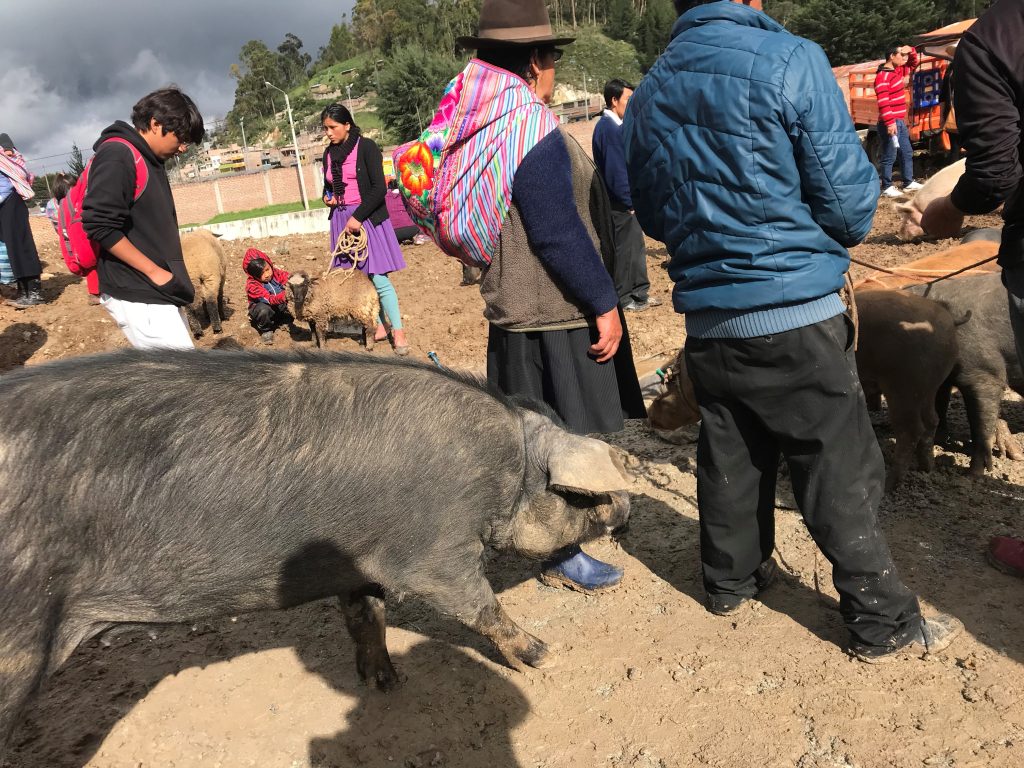
We sit on a bench at a table of fruit where a woman with a blender mixes bananas and mango with condensed milk from a tin. She feeds one small son while the other peels bananas, and she adds tree syrup, cinnamon and muña to the fusion.
“Do you want beer?” she asks. ” Then you will be singing and dancing all day!”
**************************************************
At Pachuca lake, we find families descending from tour minibuses to take a twenty minute trip on the lake, for five soles, on a paddle boat whose front bears a golden breasted mermaid. The Sirena of the lake is famous, and in the tiny square of the tiny hamlet is a statue of her seated on a rock under a fountain. At the side of the square is the church.

The paddle boat passengers have to take care, a guide tells me, for the mermaid might pull people under.
Where is she?” I ask.
The guide points towards the waters of the lake.
“Out there!”
We pass on the boat ride and instead walk a little distance around the reed-fringed lake. It is relatively warm in this sheltered valley, although we are over 3000 metres. The grass is a vivid green and alpaca graze on the shore, to Amy’s delight.
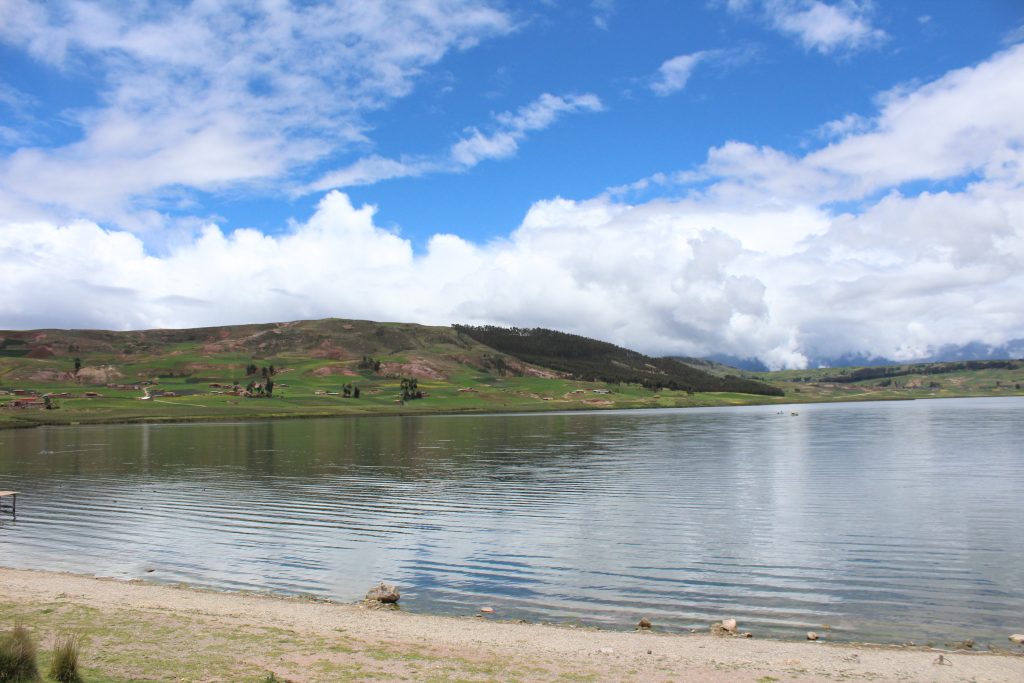
Driving into Abancay, we pass a drummer sitting on a crate outside a hardware store, whilst two scissor dancers, tijeras, take turns to perform, in their costume of bright coloured jackets and trousers sewn with mirrors.
Walking round the town in the early evening, we find a quiet square with a statue of Micaela Bastidas, the wife of Tupac Amaru, in heroic pose, arm uplifted, looking to the future and crying out. She and her husband led the 1780 rebellion against the spanish. They raised an army of 7000 but were finally defeated. The spanish executed the family in the main square in Cusco. They cut out the tongue of her son, and then hanged, him, as she watched. Then they cut off her tongue, and tried to strangle her, before clubbing and kicking her to death.
Children career across the square on home-made skateboards, squealing and laughing.
**************************************************
The next day thousands of small scale artesan miners are walking down the main road of Abancay, carrying banners saying “we pay taxes”. They, are, nearly all, short dark young men with serious faces. A few older men lead them in chants, and ocassionally the men are accompanied by similarly short dark serious women. The transport companies are marching with them. They hand out leaflets whilst police with riot shields, helmets and guns with tear gas pellets line the road.
Their grievance is that five thousand local miners create twenty thousand jobs, pay tax to the region, and employ local workers and lorry drivers. The transnational mining companies operating in the region in contrast, do not pay taxes, nor do they employ local drivers. They do not even have offices in the district.
According to the plain yellow paper sheet I have been given, the regional governor is supporting six such transnationals whilst persecuting the small scale miners. Moreover, he has appointed as Head of the Regional Energy and Mines Office an engineer from Cusco, who knows nothing of Apurimac mining. The document is signed by a committee of 18 people representing miners and transporters from towns across the region.
The hills and mountains through Ayacucho and Abancay have been high and cold, barren places, with scattered herds of alpaca, sometimes cows and sheep in the lower pastures. The valleys are narrow and steep sided, with little land for crops. But as we descend towards Cusco and the Sacred Valley we can see what a truly fertile place this is, with broad flat valleys, rich soil, and grazing for cattle and sheep.
In the Sacred Valley at Urubamba we pass impressive stone terraces by the side of the river. Ollantaytambo is full of tourists with backpacks and in the market square walks a woman with full red and black pleated skirts, red sweater, and a hat shaped like a bright red bowl filled with flowers, held on with a broad white strap under the chin. The park security guard walks up to her and shakes her hand.
There are old men in grey trousers and collared shirts, with v-neck cardigans, hurrying across the square. Girls in sweatpants and cardigan tops, or suede boots and thick woollen coats, walk in pairs through the gardens.
Walking from the modern town square down cobbled streets past a catholic church and gift shops we enter the Inca site. Mayra and Amy take the guided tour of the impressive terraces, the monolithic sun temple, and the enigmatic structures above that may have been observatories.
I wander through the grassy field below, with curious carved blocks of stone and ornamental channels of water. I look through the door of the Water Temple, along the line of the groove in the rock that leads a flow of water into the stone pool below, and beyond through the second arch, to see the valley opening out between steep sided hills beyond. The bearing is somewhere east of north.
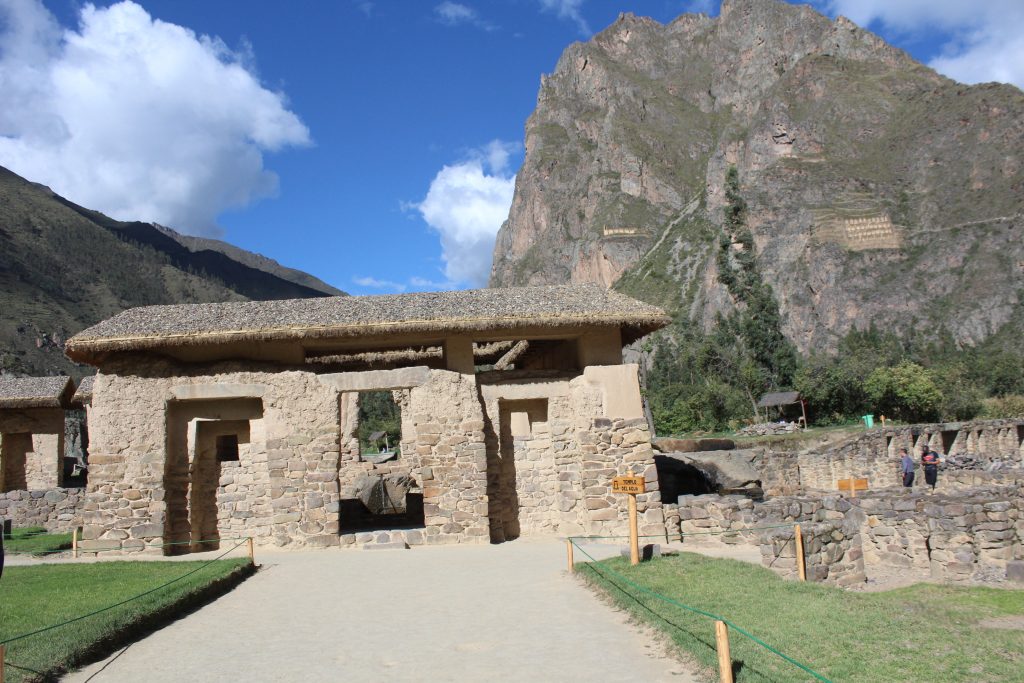
A rock below the terraces has a series of grooves that converge above the horizon at the head of the valley. The bearing is a few degrees off the point of Pleiades first rising in June, or the later June solstice sunrise.
Manco Inca staged an important victory over the spanish here, undermining the advantage of their cavalry by flooding the plain in front of the steep sided fortress. The town preserves its grid of Inca streets with water channels. Trapezoidal doorways of fine cut stone lead to courtyards where women cook and children play.
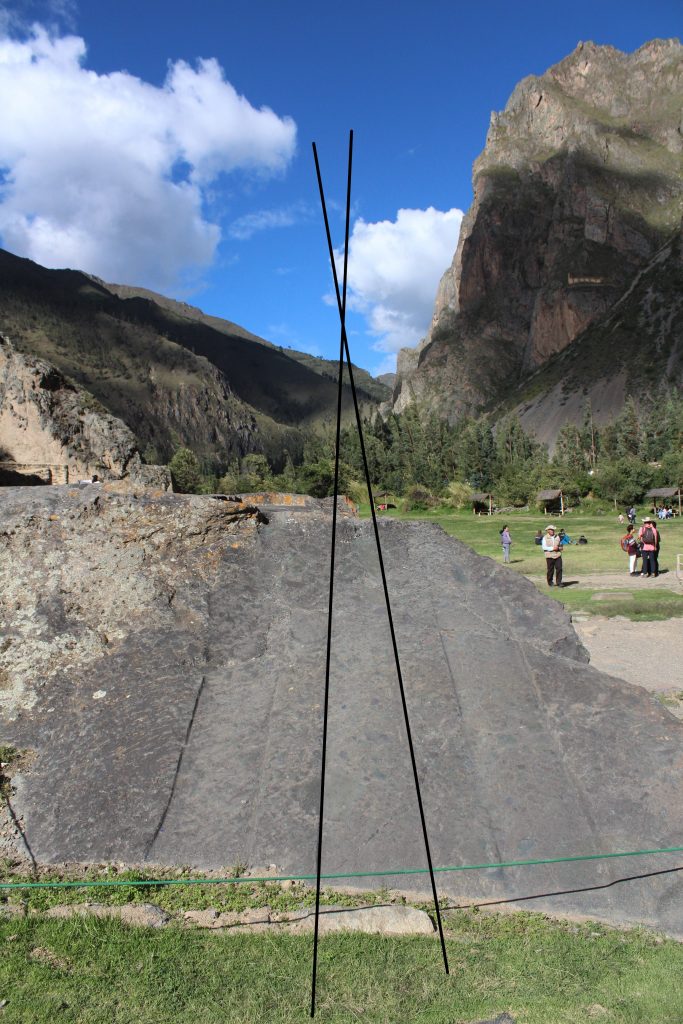
That night I look up at a night sky that is intermittently clear with wispy passing clouds. Orion stands out clearly to the west.
Propping my camera on a low wall behind the market square as small boys race their bicycles up and down the cobbles, and market traders sit on low wooden benches by a table outside eating a late meal, I take a thirty second exposure of the silver smudge of the Pleiades.
From an upstairs balcony of the hostal I look across the river to the south-west, to see Achemar rising above the mountains. Further to the east, the Milky Way, The Mayu, is a track of bright stars, above this brightly lit tourist town.
The next morning we take breakfast across the square, where a couple from Colombia are asking the young lady who serves them to translate phrases into Quechua. She does so fluently, and when they leave, she sits her three year old son at the table with a picture book and helps him pronounce the Spanish words.
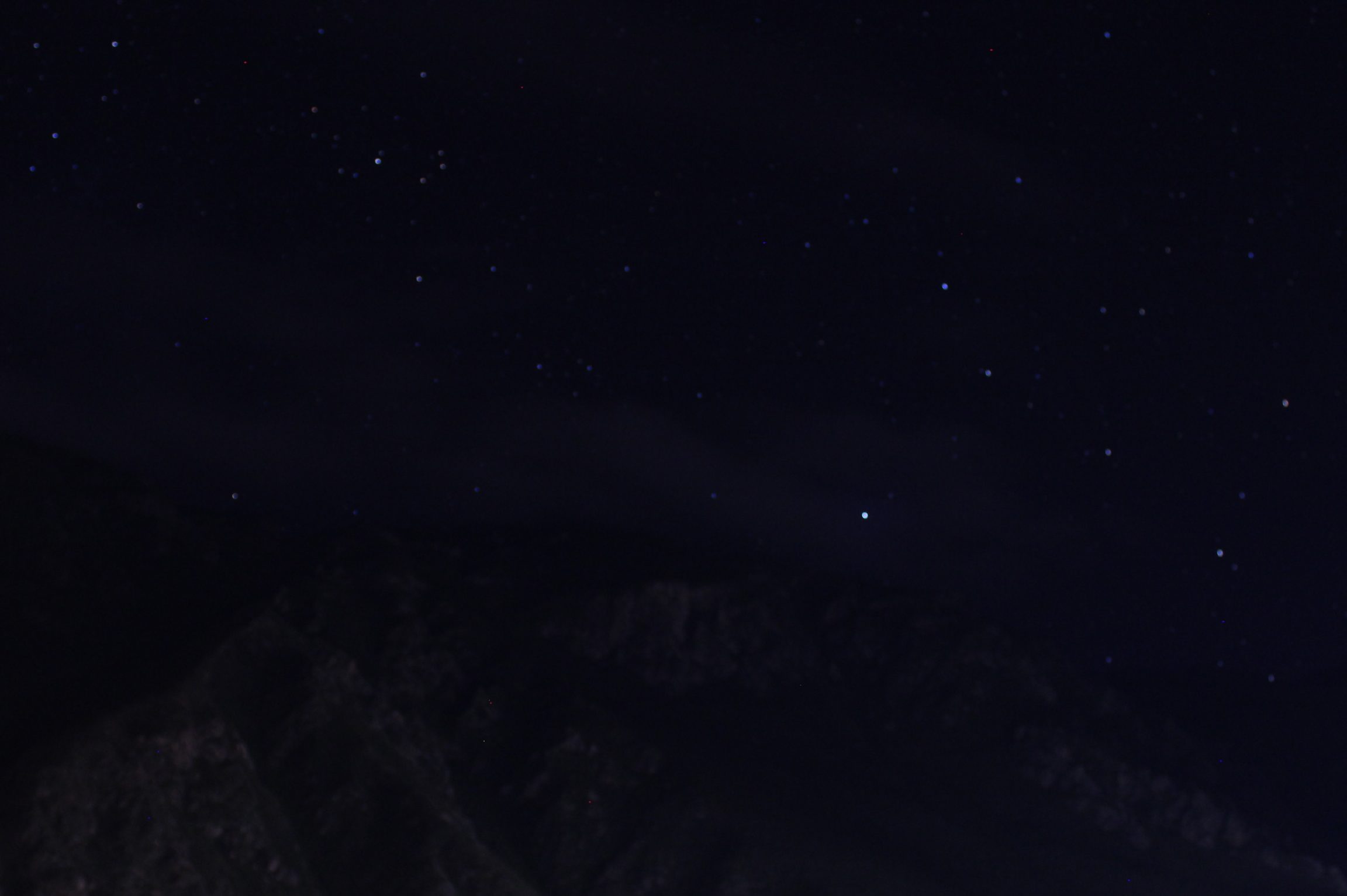
“Boca…boca…ojo…ojo…”
Looking out from the train to the town below Machu Picchu we see the river running full and brown and fast, rushing past trees and bushes stranded waist deep in the water. The carriage is only half full, but all the river-side window seats are occupied: two mature women from Kansas with a vociferous Peruvian guide, four excited young women from Japan or South Korea, with Olympus cameras, three English, a young German couple, four loud Spanish students.
Mayra and Amy take the dawn bus up the hairpin track to Machu Picchu, while I spend the morning wandering round the town of Aguas Calientes. On the banks of the river, in the cemetery and by the walkways and gardens, are giant boulders. Many have been carved into iconic Inca figures, surrounded by twining snakes, pumas, and condors. Grooves and runnels run down the sculptures channelling water. This is a watery town, with the rushing river and constant dripping rain.
Back in Cusco, walking uphill to Sacsayhuaman, we meet a group of women, in full skirts and broad red hats, following their alpacas downhill. The alpacas have red tassels in their ears and colourful woollens draped round their necks. Some women ask us to take a photograph, but most hurry on down to the more profitable alleys round the Plaza de Armas, where they will pose for photos before scurrying round the corner, whenever the police or Serenazgos come to move them on.
At the end of the winding narrow passage through the rock that leads from the circular pond that looks down on the megalithic zig zag walls, an old woman in a dark red thick wool skirt sits on the rocks.
“Toma poto” she says, “take my photo”. She is tiny, thin, with a dark brown creased face.
And so I take her photograph and give her ten soles.
“I am ninety-five. My eyes are bad. I can’t hear well in this ear. I was born here and I live here my whole life…..”
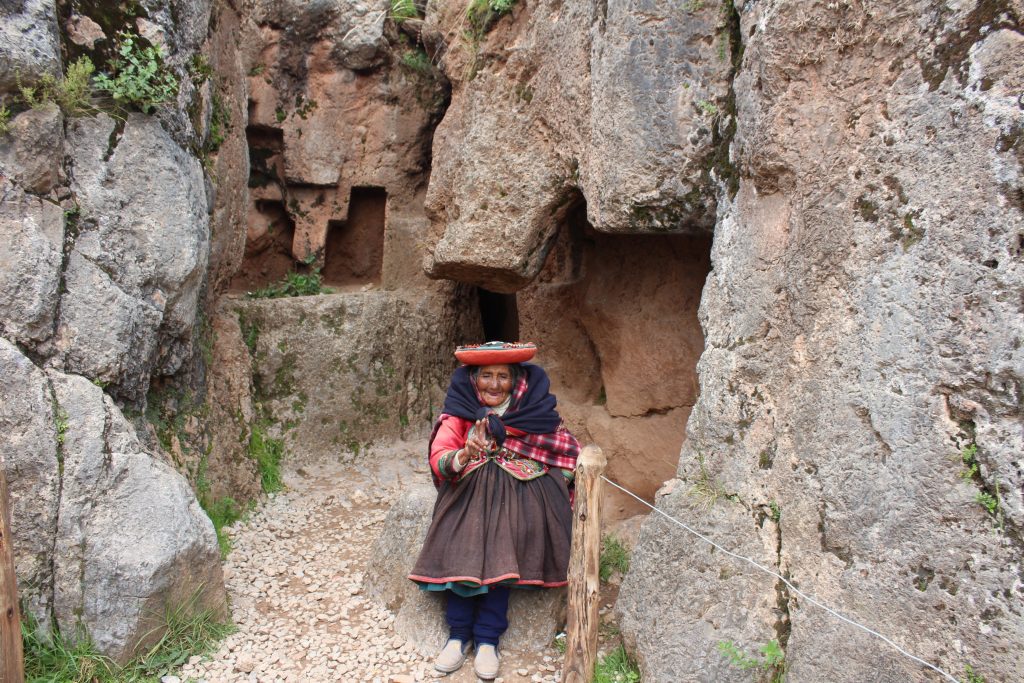
She continues talking in what seems to be mostly Quechua with the occasional Spanish.
“Gratias papacita, mamacita” she says as we leave her sitting on a rock shelf at the exit of the cavern, surrounded by carved stone steps and niches, at the top of the Inca fortress.
I must look like a young man to her.
In the Coricancha I check the alignments of the four rooms built of un-mortared dark stones, individually carved to fit together intimately on the slanted walls in characteristic Inca fashion. There is a narrow corridor on the western side, six metres long and a little more than a metre wide, aligned on a bearing of sixty-seven degrees. It is said to point towards the helical rising of the Pleiades.
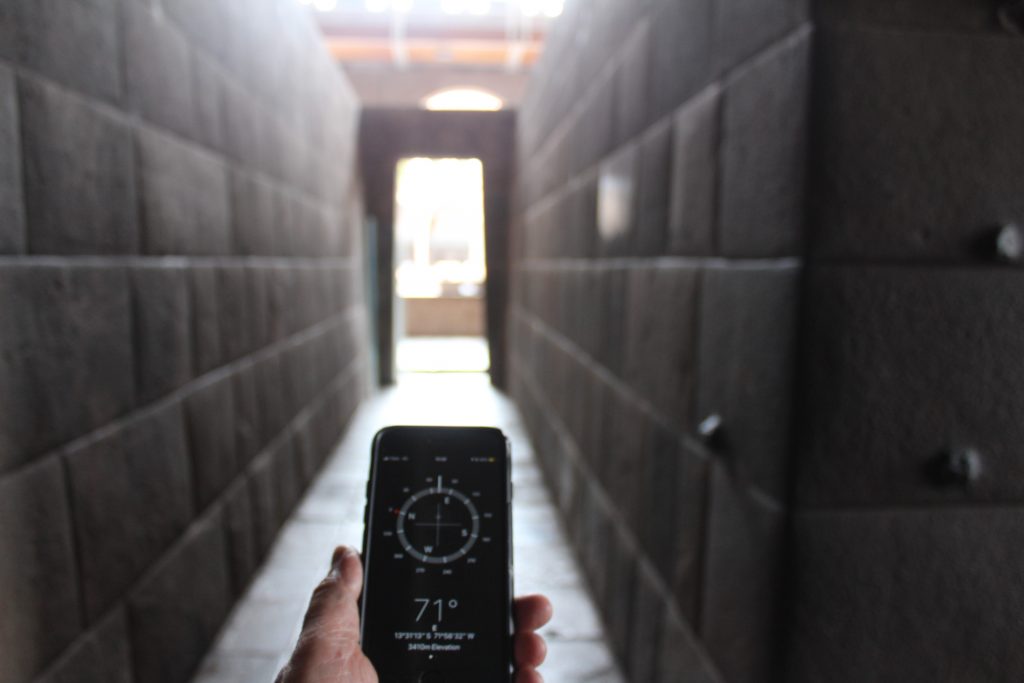
On the last two day in Cusco there is a strike, and road blockades.
“There is no problem getting to the airport,” a taxi driver tells us, “they just want to stop the big buses leaving the city.”
“It is the campesinos, the producers. Yesterday it was a big strike and today it will be bigger.”
There are lines of policemen, with helmets, shields and guns, standing by the road to the airport. With a feeling of regret, we make our flight back to Lima.
******************************************************
After the hundreds of years of campaigns by the Church and goverment to stamp out ancestor rituals, harvest celebrations, singing and dancing, native languages, community festivities, offerings to the earth and the water, it might be thought that the bullied and brutalised people of the Andes would have lost the will to celebrate.
But every year, the people of St Pedro de Casta in the district of Huarochiri carry out a community festival, the Champeria. It takes place at the end of May and in the first week of June, a little before the Pleiades rising.
The local system of canals, from its sources at 4000 metres above sea level down past the irrigated terraces to the town at 3200 metres, and then through the fields stretching on below the town to 2500 metres, a thirty kilometre long network, is thoroughly cleaned and repaired.
The whole community takes part and strong young men and women, who have moved away from the community to seek work or education in the towns, in Lima or Jauja, return to help.
A Varayoc, a staff-bearer, is chosen each year to direct the five day festival. The work is accompanied by music and dancing. And on the last day of the festival a new Varayoc is appointed for the following year.
“After completing these rituals…The huacsas, who would dance on three occasions in any given year, would finish their term on that day,” the Huarochiri Manuscript tells us, talking of similar rituals more than five hundred years earlier.
The festival today includes a horse race, and so at 4185 metres the people have built themselves a race track, thought to be the highest in the Americas, which was formally opened in 2014.
“People run a race in order to get to this mountain….driving their llama bucks. …They scramble upwards, each thinking “I mean to get there first” ”, the Manuscript tells us, for Paria Caca’s April festival.
When the communities around St Pedro de Casta celebrate the Champeria, they have specific songs, such as the Walina, accompanied by a man playing on the chirisuya, a type of oboe, and the Harawi, performed by young women. These songs talk of the moon and the sky, the flowers and the falling rain, “mother running water” and the mountains that talk.
***************************************
Back in Lima, Congress has yet to discuss the early elections proposed by the president. It has however appointed a christian fundamentalist, who claims that teaching sex equality causes cancer, as the Chair of the Education Commission.
The Congress plans to elect six new members of the Tribunal Constitutional, the TC. This body, equivalent to a Supreme Court, can block, rewrite or reinterpret laws, such as President Vizcarra’s political reforms and the bringing forward of elections. It is also the court of last resort for criminal investigations,and its powers include freeing those already found guilty, such as disgraced dictator Alberto Fujimori, or releasing those detained, such as the disgraced dictator’s daughter Keiko Fujimori. Three of its current seven members are historically corrupt.
Fuerza Popular, which now controls four parties in Congress, is recorded discussing how to take over control of the TC. The President of Congress, Pedro Olaechea, says it is an outrage that they have been taped, though it appears that the recording was made on the cellphone of one of the people involved in the conversation.
The Congress has proposed ten candidates to fill the six new positions. Six of the ten candidates, according to the leading right wing newspaper, are linked to corruption or have unresolved criminal charges against them.
President Vizcarra says that he expects a transparent and rigorous process for election of the new TC members, with publication of the candidates and appropriate time for their credentials to be assessed. He says he will make this, once again, an issue of confidence.
Congress narrowly backed down from rejecting the President’s four constitutional reforms back in July, and voted to support that motion of confidence, though they then proceeded to delay the approval of the reforms and to amend them in committee.
However, once again, if the Congress fails to support the President he will be able to dissolve Congress.
Like Francisco de Avila, Congress, and in particular the criminal alliance of Apra and Fuerza Popular, facing unprecedented disapproval levels from the people and threatened by a President promising reform, chooses to go onto the attack. Avila was accused of running illegal businesses, abusing his parishioners, fathering children. And in response he defiled sacred sites, brought cartloads of mummified ancestors and treasured relics to Lima to be burnt, and won the support of the church and political hierarchy for a holocaust. He changed the narrative, launched the extirpations, and destroyed the culture and way of life of millions of Peruvians. He is the role model for Lima’s politicos.
Time to go, I think to myself. Enough of Peru.
**********************************
29 September 2019
I walk through the Plaza de Armas where a police band is playing as guides point out to tourists the Cathedral, the Archbishop’s Palace, the Municipality and The Presidential Building, inside which the President is sitting with a hastily convened Council of Ministers. A block away, I find a handful of armed and armoured police standing outside the Tribunal Constitutional, where this highest legal body is considering whether to release Keiko Fujimori from her 18 month preventative detention. Two dogs lie sleeping against the wall. Facing the police are a dozen orange-jacketed Fuerza Popular protesters, mostly women over fifty, with hard lined faces, shouting, whilst a dozen others, sons and husbands, lean semi-detached against the wall.

I walk a few blocks further, past what was once the court of the Inquisition, where “offenders against the faith” were tortured, and I am outside Congress, where the Commission of the Constitution is deciding whether to approve the President’s proposed Reform of the process of election to the Tribunal Constitutional, the TC. The President has stated that he considers the passing of these Reforms to be a matter of Confidence. I go back to the Plaza San Martin and head to the balcony of the Hotel Bolivar to take a pisco sour and monitor developments.
The FP majority with a handful of allies rejects a proposal to discuss the Reform in the whole house, and a couple of hours later, rejects the Reform.
There are rumours that the president will make an announcement, a Message to the Nation, but instead the Prime Minister announces a press conference to be held an hour later. After an expectant wait, he appears in front of ministers to lament “We are not going to sit with our arms crossed. We are going to act with the authority and strength of the Constitution and with the responsibility that the parliament has been unable to show today.”
Later that afternoon a Congresista launches a legal denuncia, a formal request for investigation, against the President, the Prime Minister, and the Ministers of Work, Economy, the Interior, Culture, Health, Education, Justice, Energy and Mines, Production and Transport. The charge is Conspiracy. She announces her move via Twitter.
Across the road from the Hotel Bolivar, a man urinates in a doorway.
Walking through the city as the evening darkens after my Cathedral in The Hotel Bolivar, I pass massed crowds outside Papa Queens, a new fast food joint on Union. They sell bags of potato chips to take away, using only knobbly blue and red native tubers. They would sell well in Manchester.
Opposite the imposing neoclassical Palace of Justice, in the paved square in front of the Hotel Sheraton, with its life size bronzes of llamas and yoked bulls, people are dancing in the darkness.
They are rehearsing caporales, for an event in their Puño cultural centre the next day. It is nine at night. Yet there are ten groups dancing here, with banners and signboards declaring their affiliation – “tinkujs llajtaymanta”.
It is September, and they are preparing for the festival of Candelaria in January.

I was wrong to think that people are doing nothing whilst their corrupt kleptocrats savage each other and fight over the country’s wealth. Here they are, dancing for their future, dancing to change the world.
At the end of the park, in front of the the Centro de Estudios Histórico-Militares is a plinth with a bronze statue of Tupac Amaru, the husband of Micaela Bastidas, the revolutionary who after his capture in 1781 was torn apart by horses in the main square in Cusco, his body parts hung around the city.
There are more dancers above the new bypass, 400 metres long and costing 70 million dollars. OAS donated half a million dollars to the election campaign of Castañeda who implemented the bypass, constructed by OAS. The overspend is around 7 million dollars.
And wheeled carts fitted with loudspeakers sell strawberries, two kilos for three soles, arandanos, blueberries, two soles a kilo, and bananas.
*************************************************************
30 September 2019.
The next morning, Prime Minister Salvador del Solar is expected to announce to Congress that the reforms to the system of appointment of the TC will be considered a matter of confidence by the President. He walks to Congress to find that the doors to the chamber are locked from within. A crowd of Congresistas stands before him in the corridor, blocking his path.
Finally someone unlocks the doors.
Salvador del Solar enters, inclines his head to the Congress President and then walks to the centre of the chamber, looks up at the parliamentary majority benches of Fuerza Popular, and nods, a slight smile on his lips.
After summarising the importance of the Tribunal Constitutional he points out that the option to select candidates by invitation rather than open competition was only introduced in 2014.
“In 2014 the Congress spent three months evaluating the candidates … in 2017 it spent just six days assessing one candidate, and now Congress proposes to spend five days deliberating on the appointment of six new members.”
The Prime Minister, whose main career has been as an internationally acclaimed actor and film director, pauses and looks round the chamber.
“We have already presented a bill to introduce a transparent mechanism for choosing members of the TC. I therefore make this a question of confidence, here and now, whether you accept this bill or continue with your present process.”
Pedro Olaechea thanks him for his words, and then continues with the nomination of new members. The first magistrate to be elected is his cousin.
Later in the afternoon, Congress votes to support the President’s call for transparency in the appointment of members of the TC. The main opposition parties have already created a TC with a 4-3 majority in their own interests. Having continued with their dubious election, they agree to support transparency after the fact. There will be some interesting developments to come.
Time to go.
I am in a taxi to the Plaza St Martin a short time later when Canella calls me. “The President is going to make an announcement shortly. The press are in the room waiting.”
I find a live feed on my phone to hear Vizcarra revisiting the stages that had brought him to this announcement. Then he finally says it.
“He decidido disolver constitucionalmente el congreso para enfrentar los males endémicos que tanto daño le han hecho al país“: Presidente del Perú, Martín Vizcarra anuncia el cierre constitucional del Congresso…”
“I have decided to constitutionally dissolve Congress to deal with the inherent problems that are doing so much damage to our country….”
Around us, the taxi drivers and the buses begin to sound their horns, and it is a joyous sound.
Having reached to the Plaza San Martin – I thank the driver and tell him “you can tell you grandchildren you were here tonight” and he laughs – I sip a “Cathedral” on the balcony of the Hotel Bolivar and chat with a pretty waitress from Chachapoyas.
Then I walk a few blocks to join several thousand people standing outside the parliament building, inside which the now dissolved congress is pondering its options.
“Congreso, escucha, el pueblo te repudia” the crowd chants. “Listen, Congress, the people reject you”
There are a thousand or more people waving banners on Abancay, the six lane highway in front of the Congress building, climbing up the lampposts, young people, families, taking photos with their cellphones, people who want to be a part of history.
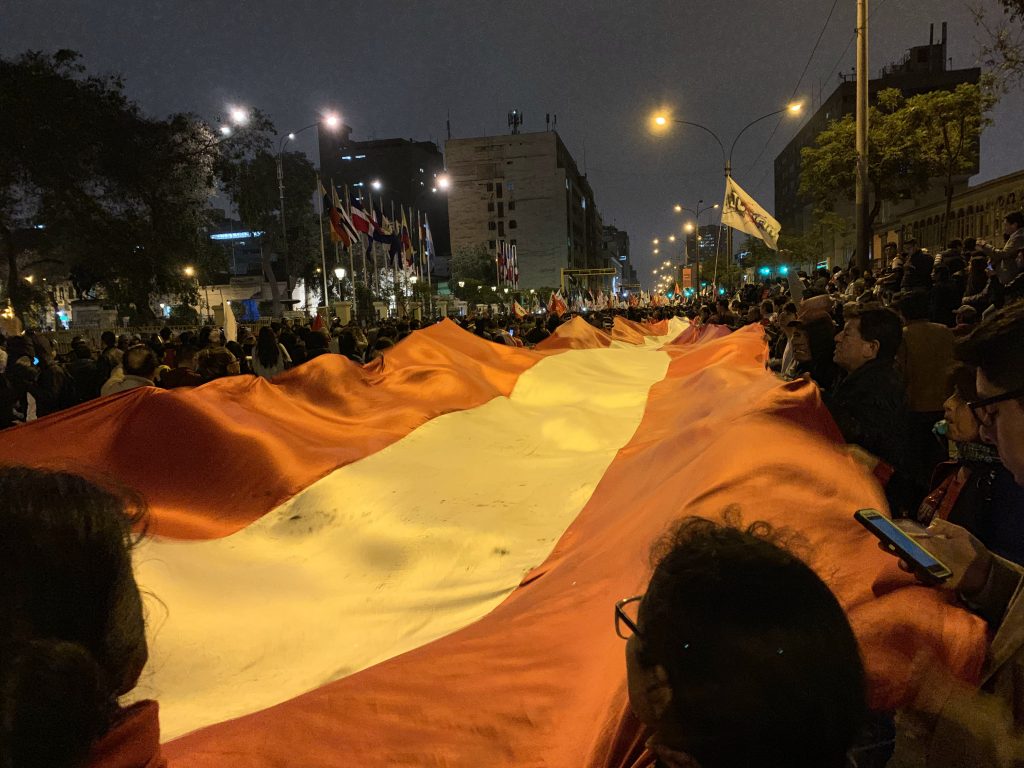
On the streets behind the building Congress staff and congresistas are leaving. Some are removing boxes of files.
“Congresas, corruptas, el pueblo te repudia“, the crowd chants. “Congressmen, Corrupt, the people reject you!”
Some Congresistas are still desperately looking for other options. People crowd round an iphone to watch the live coverage of events inside. They are debating the vacancia of the president, on the grounds that he has introduced an unconstitutional motion of confidence.
Canal N shows congresistas of the now dissolved Congress failing to reach the 87 votes needed for a vacancia, to remove the President, just reaching 79.
This circus might work if the public supported them, as they had when Alberto Fujimori launched his auto golpe, his self coup of April 5. But approval of Congress is at 8% and has been for months. At 9.04 pm, five hours after being dissolved, Congress suspends Vizcarra for a year and Pedro Olaechea swears in Meche Araoz as the new president.
She makes an emotional speech “. . . most difficult decision of my life . . .”.
Canal N subtitles her “ the new president of La Republica.” And shows members of Congress embracing and congratulating her.
Time to go.
Shortly after sunrise the next day, the Commanders of the Police, the Army, the Navy and the Air Force, joined President Vizcarra for a photo opportunity, saying he had their full support.
Lawyer and TV pundit Rosa Maria Palacios writes:
“Mire. Ya no son congresistas. Algunos lo entendieron rápido. A otros les cuesta entenderlo. Hay que dejarlos jugar a que son congresistas un ratito mas para que asimilen. Eso es todo.”
“Here it is. There are no longer any Congressmen. Some will understand this quickly. For others it will take time to sink in. We can let them pretend to be Congressmen a little longer until they realise. That is all.”
I join the crowds outside the parliament building, watching the ex-Congresistas removing their belongings. One former member is hit by an orange traffic cone thrown from the crowd. Memes and merriment abound. A TV show interviews the cone.
That afternoon, via Twitter, Meche resigns, less than 24 hours after allowing herself to be anointed president. “Half the country hates me now,” she says.
Twitter replies “JaJaJaJa the whole country hates you!!!”
Time to go.
The ONJ has announced elections for 26 January and published a timetable for parties to nominate their candidates. Seven parties have said that they will take part.
Pedro Olaechea, the short lived President of Congress, continues to fire off missives and demands, signing these spurious documents as President of Congress, and announcing them via the Congress Twitter account.
It is later revealed that Pedro Olaechea’s family is claiming around one thousand million soles ($200 million) in compensation from the state, in a legal judgement that has been stalled in the Tribunal Constitutional for many years. And his cousin, the new candidate elected to the TC by Congress in their final act before dissolution, is trying to involve Donald Trump’s lawyer, the New Yorker Rudi Guiliani, in a sale of El Comercio to US media. A sale which would have to be approved by the TC.
Time to go.
It really is time to go.
***************************************************
I turn to Mayra, sitting besides me on a bench in Barranco’s Plaza de la Familia.
” I think I have had enough of this. It is time for me to leave.”
She looks me in the eye and reaches out to hold my hand.
“Of course. Peru is a fabulous country with outstanding natural resources. Including its people. But Lima is a cocktail of stupidity, laced with historic hatred. It is unbearable to watch.”
“I am thinking to return to Europe. The world appears to be getting less stable.”
“I have spent my life in Peru and Venezuela. Instability is my normality. But it seems sometimes like dancing on a spinning table. It is difficult for me to plan for the future, and to have any trust.”
“Could you perhaps trust in me? We could make a life together. Will you come with me?”
“I have always wanted to see your red London buses, and the phone boxes. Let us make a journey and see where it takes us.”
“Amy” she calls to her sister, who is talking to the cats, “we are going on a trip!”
Go back to 152c – Conclusions and ruminations
Go forward to Appendix 1 – 36 – Chasing phones in Huacho
Go forward to Appendix 2 – 98b – Watering the desert
Go forward to Appendix 3 – 38b – Negotiating with the gods
Go forward to Appendix 4 35 – Keeping it in the Family
Go forward to Appendix 5 in Three Parts
| 110b – Where did all the people go? |
| 120b – Encomiendas, reducciones and . . . |
| 125b – Extirpaciones and Avila |
Go forward to Appendix 6 – Desert signposts across the Atacama
